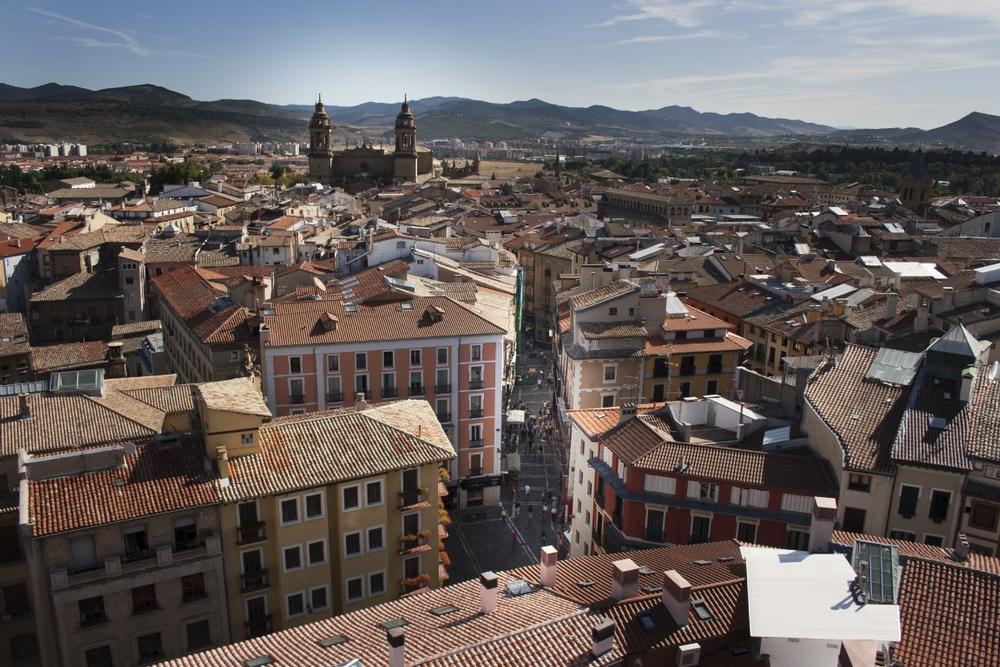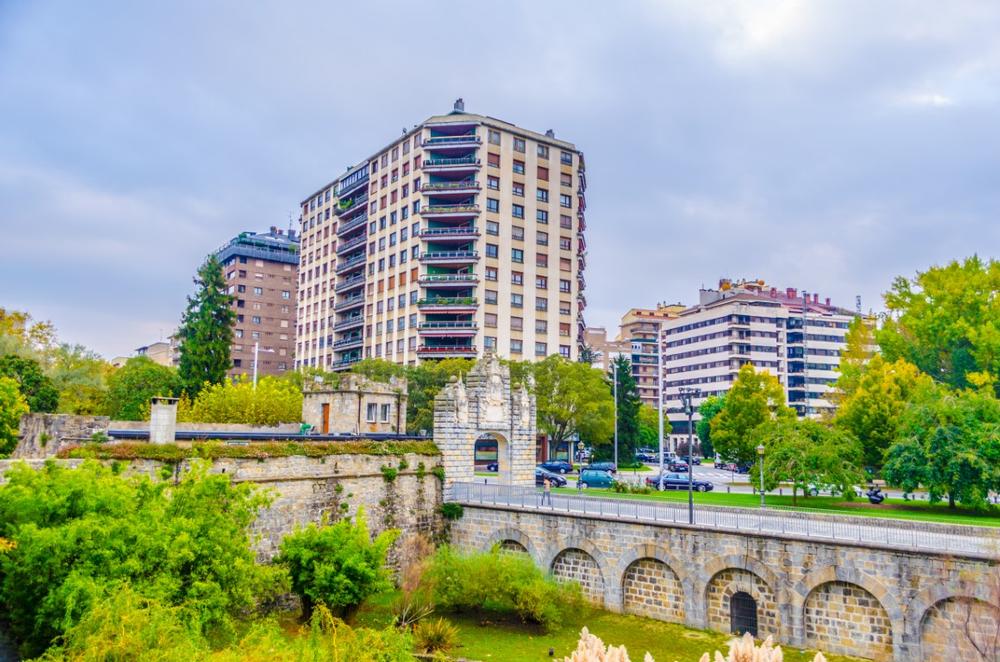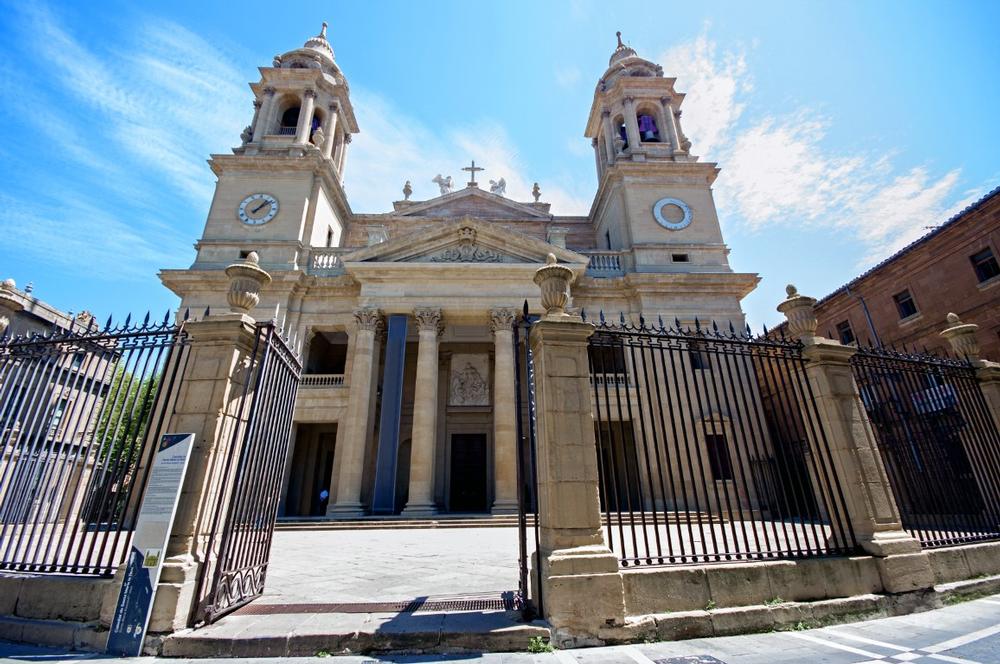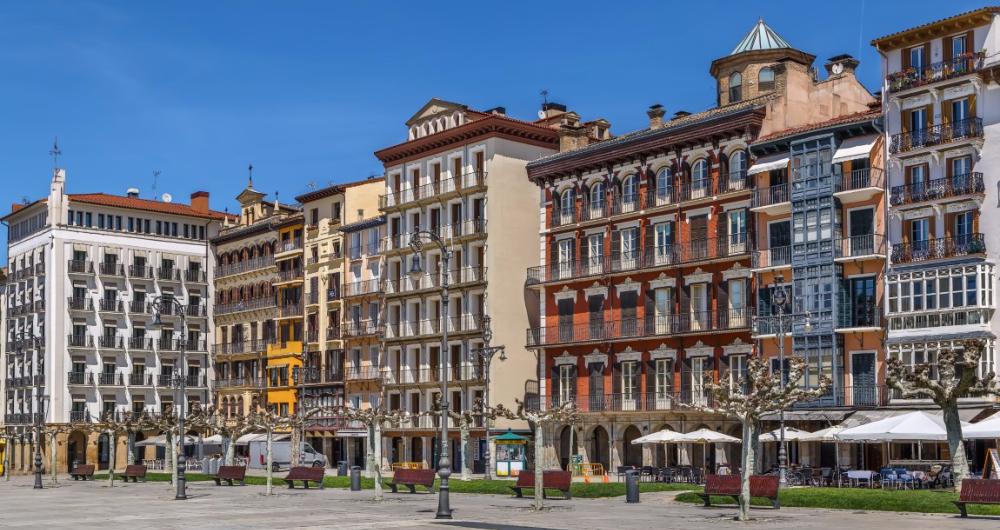In This Article
Craving medieval charm, lively festivals, and rich Basque culture? Head to Pamplona! Nestled in northern Spain’s Navarre region, Pamplona is famed for its Running of the Bulls and historic streets. From ancient ramparts to pintxos bars, Pamplona is a city where history, nature, and celebration meet year-round.
Pamplona, Spain Highlights:
- For Families: Picnic at La Taconera Park – Wander romantic gardens, see deer and peacocks, and enjoy sweeping views of the city walls.
- For Outdoor Enthusiasts: Walk the Camino de Santiago trail segment – Trek one of Europe’s most iconic pilgrimage paths as it winds through Pamplona.
- For Kids: Explore the Science Museum at the University of Navarra – Interactive exhibits and workshops make learning fun and family-friendly.
- For an Adventure: Witness the Running of the Bulls (San Fermín Festival) – Experience the thrilling festival (if you dare) or observe from safe vantage points.
- For Shoppers: Browse boutiques in the Old Town (Casco Antiguo) – Discover leather goods, handmade jewelry, and regional delicacies along cobbled streets.
🌤 When I like to visit Pamplona, Spain
The best time to visit Pamplona is from May to October, when warm weather brings out cafés, festivals, and outdoor life. July is especially popular (and crowded) due to the San Fermín Festival, while spring and early fall offer fewer tourists and pleasant temperatures.
🗺 My tips for getting to Pamplona, Spain
- If you are traveling by car: Pamplona is about 4 hours from Madrid and 2 hours from Bilbao via major highways.
- By Train: RENFE offers frequent trains to Pamplona from Madrid, Zaragoza, and Barcelona.
- By Air: Pamplona Airport (PNA) offers domestic connections; nearby Bilbao or Zaragoza airports provide international options.
- By Bus: ALSA and other providers connect Pamplona to Spanish cities and towns affordably and frequently.
🏬 Where I like to stay in Pamplona, Spain
- Hotel La Perla – Iconic luxury hotel right on Plaza del Castillo, famously favored by Ernest Hemingway.
- Maisonnave Hotel – Stylish and central, with easy walking access to Old Town and the bull run route.
- Hotel Tres Reyes – Upscale rooms and a garden setting near Ciudadela Park and the historic center.
😍 Best Things to Do in Pamplona, Spain
1. Wander Through History in Casco Viejo – Old Town

© kikebalenzategui/stock.adobe.com
The old town of Pamplona was settled in Roman times and did not expand until 1890. It is a pedestrian zone at the highest point of the city. The layout is medieval with irregular blocks and narrow but deep buildings, with vertical gaps between them. The housing is dense and the population is aging. Many of the buildings are in need of repair which is being undertaken. There are several bazaars and restaurants in the area. It is still a commercial hub and increasingly, a tourist and leisure center. The central point is the Plaza del Castillo and many of the city's monument are in the old town.
2. Walk Along the Mighty City Walls

© dudlajzov/stock.adobe.com
The walls were built in 1423 incorporating and protecting the three boroughs that made up Pamplona. In 1512 it became a strategic border outpost as a defense against the French. In 1571, the Citadel was built, reinforcing the walls with many bastions. The walls also prevented the town from expanding until 1888 when permission was granted to remove two bastions. In 1925, the southern wall was demolished. Three quarters of the wall has been conserved. Visitors can view the history at the Interpretive Center. There are two walks, along the upper and the lower parts.
3. Relax and Explore at The Citadel - Parks and Gardens

© GIRON PHOTOGRAPHY/stock.adobe.com
The Citadel and the Vuelta del Castillo, the area surrounding it form a large open space in the city of Pamplona. The citadel was built in 1571, as a border defense against constant incursions by the French. It is one of the finest examples of military architecture in Spain. It was pentagonal with a bastion at each point. It was only taken once, briefly in 1808, during a snowstorm. The area is now a park with gardens and fountains, which serves as an exhibition area for contemporary art and sculptures. Cultural events and festivities, such as fireworks displays are held at the Citadel.
4. Uncover Military History at the Interpretive Center of the Fortifications of Pamplona

© erllre/stock.adobe.com
The center is situated in five barracks in a small impenetrable fort within the city walls. The barracks have been converted into display areas depicting the evolution of the fortifications, the strategies and tactics employed, the human side of fortress life and other Spanish fortresses. The center makes use of interactive displays, audiovisuals, photographs, texts and drawings to tell the story of the walls and citadel. Graffiti etched by soldiers on duty has been conserved. From the center, visitors begin the 5 km walk along the city walls. Signposts along the way explain the various features.
5. If You Love Gothic Architecture, Marvel at the Cathedral of Pamplona

© asfloro/stock.adobe.com
The 15th century building with its 18th century facade is thought to be the third church to stand on the site. The French Gothic cloisters date back to the 13th and 14th centuries. It is a functioning Roman Catholic church and is the home of the bishop. The Cathedral has hosted marriages, coronations and funerals since the Middle Ages. Royalty, nobility and clergy are buried there. The music chapel, likewise, dates back to Medieval days and performs 50-60 times a year, during regular services and concerts, as well as nationally and internationally. The Museum of the Diocese has artwork from many abandoned churches of Navarre.
Curia Street s / n. 31001 Pamplona, Phone: +34-948-21-25-94
What to do if you are traveling with kids:
6. Experience the Heartbeat of the City at Castle Square

© lunamarina/stock.adobe.com
The Plaza del Castillo (The Castle Square of Pamplona) is the hub of Pamplona. For centuries it has been a popular meeting place and the home of important events, including the Pamplona bullfight. It is the iconic center of historic downtown. It was not formed as a result of city planning so it is an imperfect rectangle with many alleyways leading off it. Buildings of various heights, styles and periods face onto it. Its name was briefly changed to Plaza del Constuticion in 1820 and Plaza del Republica in 1873 and 1931. In the early 21st century it was remodeled and made into a pedestrian zone.
7. Discover Rich Culture at the Navarra Museum

© JackF/stock.adobe.com
Navarra Museum seeks to preserve and promote the heritage and history of the Foral Community. It was opened to the public in 1910 and moved to its present premises, the former Hospital of Our Lady of Mercy in 1956, next to the city walls in the northwest sector of the old town. Archaeological findings on the site date back to Roman times. The museum has artifacts from the Roman, Spanish Muslim, Romanesque and Gothic eras, including art, mosaics, murals and portraits. The capitals of the Cathedral cloisters are kept in the museum. The museum hosts cultural programs and educational workshops.
Activities and Attractions for Couples and Singles:
8. Stroll Through Tranquil Beauty at Taconera Gardens

© kike_fernandez/stock.adobe.com
These 9 ha gardens were first mentioned in 1719. They are the oldest and most beautiful gardens in Pamplona. Ancient trees and floral species line the broad pathways. The moat is home to free range deer, peacocks, ducks, pheasants and swans which can be viewed from above. Sculptures, fountains and triumphal arches add structural interest. The iconic Mariblanca statue, signifying abundance, is situated in the park. Monuments commemorate local 19th century musical celebrities. Benches and cafés provide places to relax and there is a play area for children. Dogs are welcome at Taconera Gardens.
9. Admire Historic Elegance at Pamplona City Hall

© Ana/stock.adobe.com
This Baroque / Neoclassical building faces the Plaza Consistorial, a small square in the heart of the old quarter of Pamplona. The building has been renovated on several occasions and was demolished in 1951 with only the facade remaining. Ionic, Doric and Corinthian columns hold up the balconies on the four-story building. The pediment depicts Fame, the one who heralds festivals. She is holding the coats of arms of Navarra and Pamplona. In the middle is a clock. Every year on 6 July at noon, all eyes are on the clock when the Fiesta of San Fermin begins.
10. If You Crave Festival Spirit, Celebrate at San Fermin, the Universal Fiesta

© Jose Hernaiz/stock.adobe.com
The Fiesta of San Fermin began as a tribute to the martyred first bishop of Pamplona. The original date was in October but autumn weather is not conducive to celebration so the festival was moved to July. The religious authorities opposed the festival for many years as it became less about the saint and more about consumption of fun, food and strong beverages. The running of the bulls is one of the founding events of the week-long festivities. The procession of the 160 year old Giants and Bigheads was added in the 19th century. The festival became an international event after Ernest Hemingway wrote about it in 'The Sun Also Rises'.
🥗 Where I Like to Eat in Pamplona, Spain
- Baserriberri – Creative pintxos and Basque fusion dishes with Instagram-worthy presentations.
- Restaurante Europa – Michelin-starred fine dining featuring regional ingredients and elegant ambiance.
- La Mandarra de la Ramos – A cozy, casual spot serving traditional Navarre cuisine and hearty daily specials.
🎟 My favorite local events:
- San Fermín Festival (July 6–14) – The famous Running of the Bulls, plus parades, concerts, fireworks, and street parties.
- Semana Santa (March–April) – Traditional Holy Week processions through historic streets.
- Jazzaldia (August) – Outdoor jazz performances in parks and plazas across the city.
🚙 My favorite day trips within 30 Minutes of Pamplona, Spain:
- Puente la Reina (25–30 min) – Cross the iconic medieval bridge and explore a key stop on the Camino de Santiago.
- Olite (30 min) – Visit the fairy-tale Royal Palace of Olite and sip Navarra wines in scenic cellars.
- Artajona (30 min) – Wander through walled medieval streets and climb up to the fortress for views.
- Eunate Church (25–30 min) – A mysterious Romanesque church with Templar legends and a tranquil rural setting.
- Bértiz Natural Park (30 min) – Hike forest trails, discover gardens, and enjoy the peace of Navarre’s lush countryside.
- Añorbe (30 min) – Visit family-run wineries and stroll vineyards in this rustic winemaking town.
- Noáin Aqueduct (15–20 min) – Walk beneath impressive 18th-century stone arches outside the city.
- Mount San Cristóbal (20–25 min) – Hike to hilltop ruins for panoramic views of Pamplona and the surrounding valleys.
- Zizur Mayor (10–15 min) – Quiet town with Camino access, local cafés, and relaxing rural walks.
📔 I get asked this a lot so I decided to include it:
-
What is another name for Pamplona?
-
Pamplona is also known by its Basque name of Iruna.
-
What is Pamplona the capital of?
-
It is the capital of the autonomous region of Navarre and the second largest city in the Basque Cultural Region, which incorporates French and Spanish territory.
-
What role did Pamplona play in history?
-
It was a fortified city that played a significant role in border defenses in the Middle Ages.
-
Where is Pamplona located?
-
Pamplona is situated in a rounded valley known as the Pamplona basin.
-
What is the climate like in Pamplona?
-
The city experiences rain all year round and temperatures around 40º Celsius in summer.
-
Why is Pamplona famous worldwide?
-
Pamplona was brought to the western world's attention when Ernest Hemingway wrote about the annual San Fermin festival and the running of the bulls, which take place annually in July.
At a Glance:
| Best Time to Visit |
Places to Stay |
Tips for Visiting |
| Spring (March-May) – Pleasant weather and fewer tourists, perfect for exploring historic sites. |
Hotel Tres Reyes – A modern and comfortable hotel near the city center. |
Walk along the Ciudadela Park – Enjoy the green spaces and historic fortress. |
| Summer (June-August) – Warm and lively, especially during the famous San Fermín festival. |
Gran Hotel La Perla – A historic luxury hotel in the heart of Pamplona. |
Attend the Running of the Bulls – Experience the world-famous festival in July. |
| Fall (September-November) – Cooler temperatures and beautiful autumn scenery, great for food lovers. |
Hotel Europa – A stylish stay known for its excellent gastronomy. |
Try local pintxos – Visit the bars in the Old Town for traditional Basque tapas. |
| Winter (December-February) – A quiet and festive season with charming holiday decorations. |
Albret Hotel – A cozy and budget-friendly option. |
Visit the Pamplona Cathedral – Explore this stunning Gothic landmark. |
🖋 How did I do?
Is the article too broad, too narrow, or just right ? Do you like the presentation of photos and text? Let me know in the comments! If you want to see more in this location, I can put it on my editorial calendar. I'm listening!
Plan Your Trip












